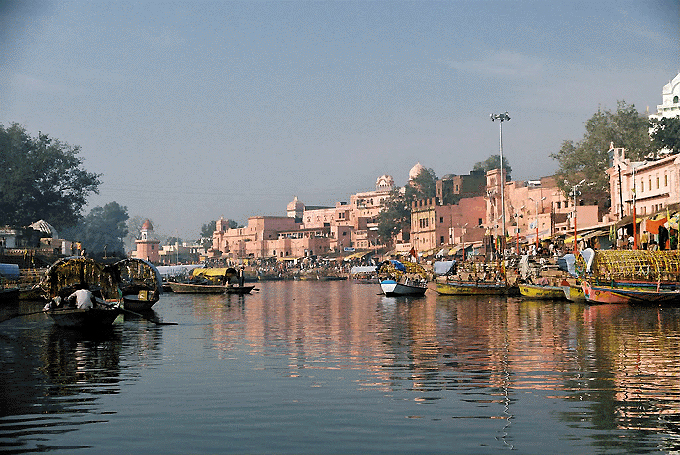
Ram Ghat
On the banks of the river Mandakini, and as a center of ritual activity, this Ghat is the most frequented in Chitrakoot. The “Aarti” performed in the evening is particularly beautiful. During the exile period Rama, Lakshmana and Sita took bath here. It is also known as the place where the sage Tulsidas (who wrote Ramacharitamanas) got darshan of his Lord Rama. The devotees usually take a dip here before going for Parikrama and darshan of Kamtanath ji. There is a group of temples here on the Ghat which is known as Puri and some devotees go around this group of temples also in the Parikrama. Many important places like Raghava Prayag Ghat, Mattgajendreshwar Swami, Parna Kuti and Yagya Vedi are nearby.
Kamadgiri
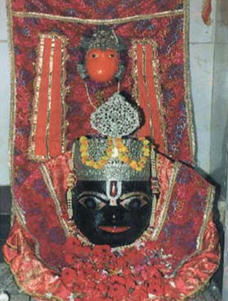
The sanskrit word ‘Kamadgiri’ means the mountain which fulfills all the desires. Kamadgiriis a place of prime religious significance. A forested hill, it is skirted all along its base by a chain of
temples and is venerated today as the holy embodiment of Rama. Lord Rama is also known as Kamadnathji which literally means fulfiller of all wishes.The Hill appears like a bow seen from any place in Chitrakoot. The pilgrimage path around this hill is about 5 Km long
A forested hill of prime religious significance, this is believed to be the original Chitrakoot. The Bharat MilapTemple is located here. Pilgrims perform a ritual circumambulation of the hill to seek blessings.
Räma’s brother Bharata had been away from Ayodhyä when Räma was exiled. When Bharata returned, he learned that he was supposed to be the king in Räma’s absence. Greatly disturbed by this news, Bharata went with a large retinue to Chitrakut to ask Räma to come back and rule the kingdom. Today, the Räma-BharataMilap commemorates the spot where they met.
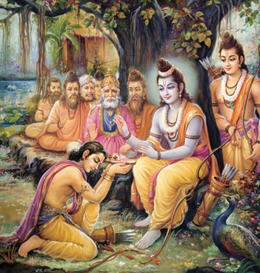
Lakshman Pahadi
A small hillock, parallel to and to the east of the Kamadgiri, about half- way in the Parikrama, is known as LakshmanPahadi. Lakshman used to guard Sri Ram and Sitaji from here, while they rested on the Kamadgiri. There is a Lakshman Temple here and also a Lakshman-Stambh. The visiting pilgrims embrace this pillar with the same reverence as if they were embracing LakshmanJi himself. There is a flight of steps from the ParikramaMarg leading to this hillock.
Saryu Dhara

There is a small streamlet above the fourth Mukharvind of KamtanathJi known as SaryuDhara. It is believed that Hanuman Ji lives here and there is a popular legend that Tulsidas used to recite the Ramayan here everyday before him. The devotees feel spiritually charged after resting here for a while
Mattagajendreshwar Swami
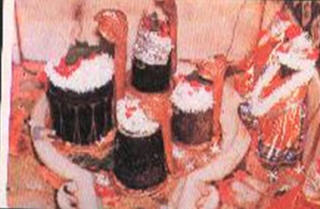
The famous temple of Mattagajendreshwar or MadganjanSami is situated on the Ramghat. According to a pauraniklegnd, Lord Brahma offered penance here in the Satyug and installed a Shivling here as Kshetrapal (i.e. protector of the area) which was known as Mattgajendreshwar Swami.
Later when Sri Ram came to Chitrakoot, he did Rudrabhishek here after bathing here in the Payaswini. Much later, Raja AmanSingh,the King of Panna built a temple here.
Raghav Prayag Ghat
This is to the south of the Ramghat of the Payaswini and is the convergence point of the three rivers—the Payaswini ,theMandakini and the Gayatri (or the Savitri ,a river not visible to the eye) meet here. Lord Ram performed the pitratarpan ceremony (sacred offerings to a deceased father by his son) for King Dashrath, who had died after Lord Ram’s exile. It is believed that even the king of teerths, Prayagraj also comes once every year to absolve himself of all the sins by taking a dip here.
Although Bharata was sorry about Räma’s exile, Räma was undisturbed. Bharata insisted again and again that Räma should come back to Ayodhyä, and many others who had come with Bharata agreed. But Räma repeatedly refused the kingdom. “No, I’ve given my promise to my father. That’s more important.”
Finally, Räma gave the decision over to JanakaMahäräja, his father-in-law.
Räma said, “JanakaMahäräja is very experienced, religious, and expert—let him decide whether I should stay here in Chitrakut and complete the term of exile or go back to Ayodhyä and take up the kingship.”
JanakaMahäräja, knowing the purpose of the Lord, said that Räma should stay in Chitrakut.
When Lord Ram refused to come, Bharat carried Lord Rama’s holy sandals with him. Even today the holy foot prints of both Ram and Bharat are imprinted here.
YAGYA-VEDI
This is near the ParnKuti on the Ramghat. It is said that Lord Brahma performed Yagyas here. Hence, the name.
JanakiKund
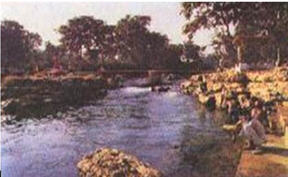
Temples are also at Jänaki-kunda, where Sitä, or Jänaki, would bathe. There are two Jänaki-kundas. One is at Gupta Godävari, and the other is three kilometers from Räma-ghäta.. The rocks nearby bear the foot prints of JanakiJi.
SphatikShila

This picturesque spot is marked by two immense rocks. It is believed to be the place where Lord Rama and Sita feasted their eyes on the beauty of Chitrakoot. This bears the Rama’s footprint and Sita. It is said that Lord Rama with his own hands did Shringar of his wife Sita and where Sita was pecked at by Jayant(indra’s son)in the form of crow.
‘Sphatik’ is a Sanskrit word meaning a crystal. There is a huge rock resembling a reddish-white crystal, about 1 Km. away from Janaki-kund on the left bank of the Mandakini. Sri Ram and JanakiJi used to rest here perhaps while going to and coming from the Atri Ashram.
Once, Jayant, the son of Indra pecked at the feet of SitaJi to test the might of Sri Ram. Thereupon, Ram, sitting in the veerasan Posture, released a grass as an arrow at him. Jayant could not find anyone who could protect him against this grass-arrow and ultimately sought shelter with Lord Ram himself, who pardoned him after taking one of his eyes as punishment. The rock bears the foot prints of Sri Ram, SitaJi and Jayant.
Hanuman Dhara (waterfall)
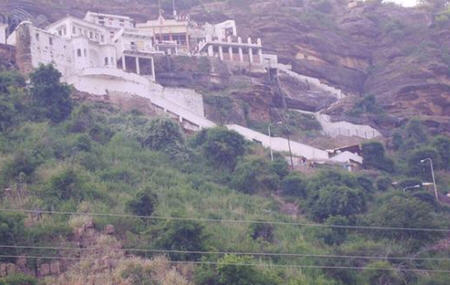
Four kilometers from Ramghat it is one of the mountain ranges close to Mandakini Ganga. 360 steps climb lead you to this waterfall. Local people say that Hanumanji after burning lanka was advised by Lord rama to come here and bathe in the sweet cool nectarean waterfalls and thus get relieved from heat. This waterfall is originating from within the mountain slopes. 100 steps more up is a place called Sitarasoi (Sitas kitchen) where Sitadevi would cook simple food – roots and fruits for Lord.
Vanadevisthan
3 kms from Ramaghat, on the way to Hanuman dhara. Kula devi of Ayodhya known as Vanadevi came to reside here when Lord Rama, Sita and Laxman left Ayodhya and came here. Goddess Sita footprints are still seen here.
Gupt Godavari

This is a tiny rivulet which flows into tanks at the end of an underground cave. The source of this rivulet remains unfathomable. Two natural throne-line rocks in the cave have led to the belief that Lord Rama and his brother Laxman held court here.
2 beautiful caves on the mountain were made by demigods knowing of Lord Ram’s coming here. To serve Lord Ram, Godavari was invoked here from the cave. Hence named as Gupt (hidden) Godavari.Devoteesvisting this place can enter this cave even today and experience the divine atmosphere of walking in knee deep Godavari waters.
Bharat Koop (well)
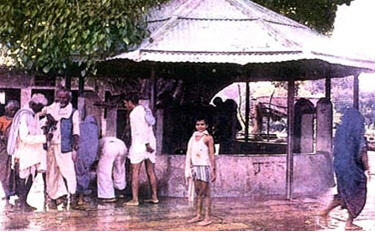
Situated on Allahabad highway, this is famous well where Bharat emptied the entire water which was carried by him for Lord ram’sabhishek in Chitrakut. This collection of water was from various holy rivers and ponds. Finding it of no use, the sages advised bharat to empty them all in this well
Just near Bharatkoop there is a temple of Mandvi, the consort of Bharat and there is also a Bharat Mandir nearby.
Sati Anasuya ashrama

13 km from Ramghat. It was here that Atri Muni, his wife Anasuya meditated and had their residence. An ashram in Anasuya’s name is located here. It is believed that the Mandakiniriver emerged as a result of Anasuya’s meditation.
Sati Anusuyaashrama is set amidst thick forests that round to the melody of birdsong all day.
As per description of Valmiki at one time there was no rain in Chitrakuta for ten years. There was a severe famine and nothing was left to eat or drink for animals and birds. Sati Anusuya performed hard and intensive austerities and got the river Mandakini down on earth. This led to the greenery and forests to grow which removed the sufferings of all sages and the animals.
Currently, Sati Anusuya ashrama is a very peaceful place where various streams from the hills converge and form the Mandakini River. It is said that Rama along with Sita had visited this place to meet Maharishi Atri and Sati Anusuya.

It is here that Sati Anusuya explained to Sitathe famed lessons on Chastity. The dense forests of Dandaka start from this place. It was ruled by Ravana. Ravana had appointed strong rakshasas like Khara and Viradha as its rulers. The place was infected by the terror of rakshasas.
RAM-SHAIYYA
This place is near the Bihara village about 3 kms west of kamadagiri mountain. At this place situated between two mountains one can still see body markings of both ram and sita and marking of Lord ram’s bow between the two.
LAKSHMAN-CHOWKI
About 100 Mt. away from the Ram-Shaiyya rock and overlooking it there is another rock which is known as Lakshman-Chowki. It is believed that Lakshman used to be on guard here to protect Sri Ram and SitaJi. This beautiful rock bears a mark resembling the head side of a bed. It also has imprints which are believed to have been made by Lakshman sitting down with his bow by the side. The Ram-Shaiyya rock is clearly visible from here.
SARBHANG ASHRAM
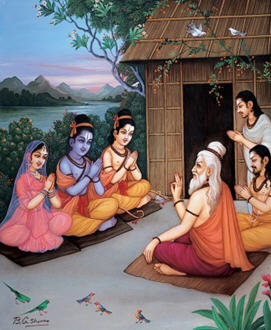
This Ashram is situated at a distance of about 20 Km. to the south east of Sati Anasuya Ashram. There is a Ganga-Kund and a Shiva Temple here. Beside the Ashram, there are 108 YagyaVedikas at the foot of the hill. Sri Ram accorded darshan to the sage Sarbhang here during his forest sojourn. Bathing in the Ganga-Kund of this Ashram has a special religious significance. The saying is that one dip in the Sarbhang Ashram equals repeated bathing in the sacred Ganges.
SUTIKSHNA ASHRAM
This is one of the most beautiful and charming sites in Bundelkhand. Ram appeared to MaharshiSutikshna here in compliance of the latter’s desire to have His darshan. A beautiful stream flows down from amidst the mountains falling in a kund below, probably giving its current name Dharkundi. This Ashram is situated about 4 Km. to the north of Sarbhang Ashram.
VIRADH – KUND
About 6 Km. to the east of the Shabari Fall (near Jamunihai village ) and at the meeting point of Bambiha and Tikariya villages on the Amrawati Ashram road, there is a vast reservoir of water known as Viradh–Kund. According to a popular belief, this reaches down to the PatalLok . There is a well accepted legend that a terrible monster Viradh used to live here and was later killed by Sri Ram during his exile. This Kund was the monster’s place of shelter and through it he could escape down to the another world ( i.e. Patal ).


